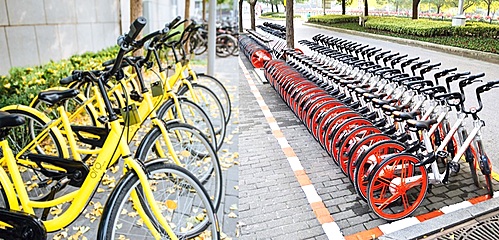List
Story > NEWS > Detail
[News] Development of Shared Bicycles in China
According to Lessig, a shared economy refers to the economic activity of collaborative consumption, in which several products produced once are shared. After emerging as an alternative to global problems such as economic stagnation and climate change, the shared economy is significant in creating a consumption pattern that places value in use over the value of ownership of goods, spreading a rational and meaningful consumption culture, and contributing to the attainment of a sustainable society. Currently in China, the craze for shared economy is rising and emerging shared economy models such as shared umbrella, shared mobile power and shared health facilities, as well as in the transportation sector, are affecting Chinese consumers' daily lives of Chinese consumers.
In particular, shared bicycles have emerged as a new consumption trend that implements shared concepts by applying mobile communication technology. China's shared bicycle system is a bicycle intelligent transportation model that identifies bicycle location through app, unlocks it using smart method such as QR code identification, and monitors bicycle operation status in real time through the central management center, and has advantages such as high degree of freedom in terms of use, convenience of rental and return, and low price. Looking at the shared bicycle market in China, monthly user size increased from 540,000 to 70 million from July 2016 to May 2017. In addition, shared bicycle became a major mode of transportation, ranking fourth in the rankings of small cars, buses, and subways within a year of market input.

Shared bicycles represent an effect in solving consumers' short-distance traffic demand, or "last kilometer," and are considered to be of great social use, such as easing traffic congestion. In fact, in the first half of 2017, the traffic congestion during rush hour dropped by nearly 16% in three areas with high use of shared bicycles in Beijing, proving that shared bikes are effective in mitigating traffic congestion. In addition, it is assessed that the transfer of the share is an environmentally-friendly and sustainable economic model that gives consumers the perception that it is a low-carbon transportation method due to the effect of reducing air pollution, and has meaningful effects in various areas such as practice of environmental protection ideology, exchange of people and health promotion.

China's shared bike system has developed through three stages. From 2007 to 2010, the first phase of the shared bike system was the government-led operation, with the introduction of a model of public bikes originating from abroad into China. At this time, the station was a must-have device for the shared bike system. From 2010 to 2014, companies specializing in shared-bicycle systems appeared, but as with the first stage, stations were set up. In the third stage, in 2014, shared bicycles connected to the Internet emerged, focusing on businesses such as Ofo and Mobike, following the rapid development of mobile communication technology. The shared bike system in the third stage could be called an innovative system that can check the real-time location of the bicycle by applying mobile communication technology without requiring a station, which triggered the activation of the shared bike.

Looking at the recent market status of shared bicycles in China, the number of shared bicycle users topped 70 million, of which shared bicycle company Ofo ranks first and second in the shared bicycle market with 54.1 percent and Mobike 49.5 percent. Other shared bike companies have a market share of less than 5 percent. The two companies' goals are somewhat different: Ofo first emerged as a means of transportation on a university campus in Beijing, and Mobike is offering differentiated services to consumers, focusing on solving the 'last kilometer' problem of daily commuting for urban residents. The characteristics of China's shared bike system can be arranged in four ways: First, shared bicycle is a model of shared economy. By separating ownership and usage rights, the company can enhance economic efficiency and share and use products once produced, making it a useful means for the drive for sustainable development. Second, the rapid development of mobile communication technology and the spread of smartphones became the basis for the development of shared bicycles. First, with the growth of Web 2.0, advances in information and communication technology have enabled the development, sharing and cooperation of online shared platforms.

In particular, the spread of 4G networks and the Internet of Things affected the rapid expansion of Chinese shared bicycles. Third, shared bicycles are short-distance transportation, and show advantages in many ways. The shared bicycle is a city short-distance transportation that connects transportation, such as subways and buses, with places of living and jobs. In addition, shared bicycles play a supplementary role as a means of transportation when it is difficult to catch a taxi or when traffic is heavy. Fourth, shared bicycles have positive social utility as well as features such as high freedom in terms of use, convenience of renting and returning, and low price. Innovative shared bicycles have again emerged as an important means of transportation, creating a social atmosphere for reducing car use, resulting in air protection, alleviating traffic jams and enhancing the health of shared bicycle users. In terms of these positive effects, it is very meaningful to understand the behavior of consumers using shared bicycles and to seek to activate the shared bike system based on them.
According to Lessig, a shared economy refers to the economic activity of collaborative consumption, in which several products produced once are shared. After emerging as an alternative to global problems such as economic stagnation and climate change, the shared economy is significant in creating a consumption pattern that places value in use over the value of ownership of goods, spreading a rational and meaningful consumption culture, and contributing to the attainment of a sustainable society. Currently in China, the craze for shared economy is rising and emerging shared economy models such as shared umbrella, shared mobile power and shared health facilities, as well as in the transportation sector, are affecting Chinese consumers' daily lives of Chinese consumers.
In particular, shared bicycles have emerged as a new consumption trend that implements shared concepts by applying mobile communication technology. China's shared bicycle system is a bicycle intelligent transportation model that identifies bicycle location through app, unlocks it using smart method such as QR code identification, and monitors bicycle operation status in real time through the central management center, and has advantages such as high degree of freedom in terms of use, convenience of rental and return, and low price. Looking at the shared bicycle market in China, monthly user size increased from 540,000 to 70 million from July 2016 to May 2017. In addition, shared bicycle became a major mode of transportation, ranking fourth in the rankings of small cars, buses, and subways within a year of market input.

Shared bicycles represent an effect in solving consumers' short-distance traffic demand, or "last kilometer," and are considered to be of great social use, such as easing traffic congestion. In fact, in the first half of 2017, the traffic congestion during rush hour dropped by nearly 16% in three areas with high use of shared bicycles in Beijing, proving that shared bikes are effective in mitigating traffic congestion. In addition, it is assessed that the transfer of the share is an environmentally-friendly and sustainable economic model that gives consumers the perception that it is a low-carbon transportation method due to the effect of reducing air pollution, and has meaningful effects in various areas such as practice of environmental protection ideology, exchange of people and health promotion.

China's shared bike system has developed through three stages. From 2007 to 2010, the first phase of the shared bike system was the government-led operation, with the introduction of a model of public bikes originating from abroad into China. At this time, the station was a must-have device for the shared bike system. From 2010 to 2014, companies specializing in shared-bicycle systems appeared, but as with the first stage, stations were set up. In the third stage, in 2014, shared bicycles connected to the Internet emerged, focusing on businesses such as Ofo and Mobike, following the rapid development of mobile communication technology. The shared bike system in the third stage could be called an innovative system that can check the real-time location of the bicycle by applying mobile communication technology without requiring a station, which triggered the activation of the shared bike.

Looking at the recent market status of shared bicycles in China, the number of shared bicycle users topped 70 million, of which shared bicycle company Ofo ranks first and second in the shared bicycle market with 54.1 percent and Mobike 49.5 percent. Other shared bike companies have a market share of less than 5 percent. The two companies' goals are somewhat different: Ofo first emerged as a means of transportation on a university campus in Beijing, and Mobike is offering differentiated services to consumers, focusing on solving the 'last kilometer' problem of daily commuting for urban residents. The characteristics of China's shared bike system can be arranged in four ways: First, shared bicycle is a model of shared economy. By separating ownership and usage rights, the company can enhance economic efficiency and share and use products once produced, making it a useful means for the drive for sustainable development. Second, the rapid development of mobile communication technology and the spread of smartphones became the basis for the development of shared bicycles. First, with the growth of Web 2.0, advances in information and communication technology have enabled the development, sharing and cooperation of online shared platforms.

In particular, the spread of 4G networks and the Internet of Things affected the rapid expansion of Chinese shared bicycles. Third, shared bicycles are short-distance transportation, and show advantages in many ways. The shared bicycle is a city short-distance transportation that connects transportation, such as subways and buses, with places of living and jobs. In addition, shared bicycles play a supplementary role as a means of transportation when it is difficult to catch a taxi or when traffic is heavy. Fourth, shared bicycles have positive social utility as well as features such as high freedom in terms of use, convenience of renting and returning, and low price. Innovative shared bicycles have again emerged as an important means of transportation, creating a social atmosphere for reducing car use, resulting in air protection, alleviating traffic jams and enhancing the health of shared bicycle users. In terms of these positive effects, it is very meaningful to understand the behavior of consumers using shared bicycles and to seek to activate the shared bike system based on them.



